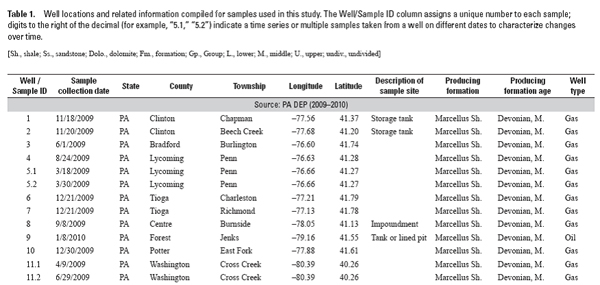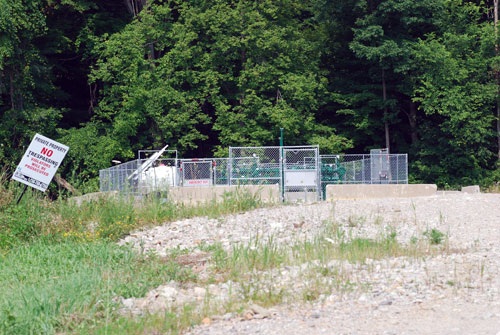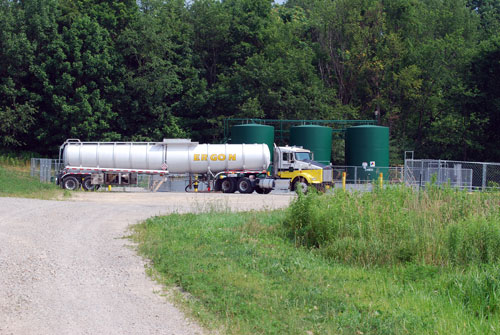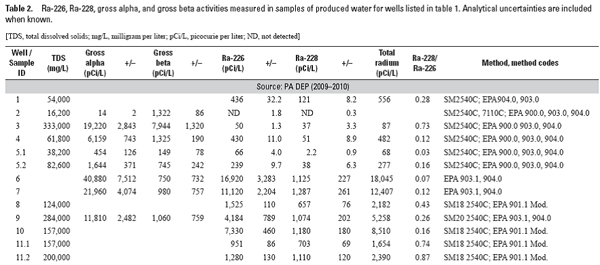RADIOACTIVITY IN SHALE
|
|||||||||||||||||||||||||||||||||||||||||||
Radioactivity is a very important topic, on multiple levels, when considering all the environmental impacts of fracking for oil and natural gas. While most media attention is focused on the chemicals going downhole in the fracking process, it is just as important to realize that 'Mother Nature' sends her own group of toxics back out of these Marcellus Shale wells in the flowback right away, and the produced water over time. |
|||||||||||||||||||||||||||||||||||||||||||
Two of these toxics are water
soluble Radium 226 (Ra226) and Radium 228 (Ra228). An investigation by the New York Times in
2010 was very effective in demonstrating the presence of radioactivity
in these fluids from Marcellus Shale wells.
As an example of one fracked Marcellus well they researched, well #6H in
Cross Creek County Park, Washington County, Pennsylvania, had alarming levels of Ra 226,
Ra 228 along with Uranium 238 in the flowback liquids.
Where was this liquid waste (*brine*) disposed of? Someone's glass of water? Pennsylvania DEP reports indicate that the fate of the majority of that radioactive wastewater (168,336 gallons) is unknown, most of the wastewater at that time was being taken to sewage treatment plants, diluted with processed sewage, and dumped into the rivers around Pittsburgh; the drinking water source for hundreds of thousands of local residents. Who says that fracking has never contaminated water? Indeed, it has contaminated drinking water for hundreds of thousands, if not millions of people living near shale drilling. This page will provide further evidence linked to the radioactivity, and solubility, of that threat to the safety, health and welfare of those living close to, or downstream from shale fracking. |
|||||||||||||||||||||||||||||||||||||||||||
|
|
|||||||||||||||||||||||||||||||||||||||||||
|
NORM encountered in oil and gas exploration, development and production operations originates in subsurface formations, which may contain radioactive materials such as uranium and thorium and their daughter products, radium 226 and radium 228. NORM can be brought to the surface in the formation water that is produced in conjunction with oil and gas. NORM in these produced waters typically consists of the radionuclides, radium 226 and 228. In addition, radon gas, a radium daughter, may be found in produced natural gas. Because the levels are typically so low, NORM in produced waters and natural gas is not a problem in Texas unless it becomes concentrated in some manner. Through temperature and pressure changes that occur in the course of oil and gas production operations, radium 226 and 228 found in produced waters may co-precipitate with barium sulfate scale in well tubulars and surface equipment. Concentrations of radium 226 and 228 may also occur in sludge that accumulates in oilfield pits and tanks. These solids become sources of oil and gas NORM waste. In gas processing activities, NORM generally occurs as radon gas in the natural gas stream. Radon decays to Lead-210, then to Bismuth-210, Polonium-210, and finally to stable Lead-206. Radon decay elements occur as a film on the inner surface of inlet lines, treating units, pumps, and valves principally associated with propylene, ethane, and propane processing streams. Workers employed in the area of
cutting and reaming oilfield pipe, removing solids from tanks and
pits, and refurbishing gas processing equipment may be exposed to
particles containing levels of alpha-emitting radionuclides that
could pose health risks if inhaled or ingested. |
|||||||||||||||||||||||||||||||||||||||||||
|
|
|||||||||||||||||||||||||||||||||||||||||||
|
The geologic formations that contain oil and gas deposits also contain naturally-occurring radionuclides, which are referred to as "NORM" (Naturally-Occurring Radioactive Materials). Geologists have recognized their presence since the early 1930s and use it as a method for finding deposits (Ma87). Much of the petroleum in the earth's crust was created at the site of ancients seas by the decay of sea life. As a result, petroleum deposits often occur in aquifers containing brine (salt water). Radionuclides, along with other minerals that are dissolved in the brine, precipitate (separate and settle) out forming various wastes at the surface. Because the extraction process concentrates the naturally occurring radionuclides and exposes them to the surface environment and human contact, these wastes are classified as TENORM. TENORM contamination levels in equipment varied widely among types of equipment and geographic region. The geographic areas with the highest equipment readings were northern Texas and the gulf coast crescent from southern Louisiana and Mississippi to the Florida panhandle. Very low levels of TENORM were found in California, Utah, Wyoming, Colorado, and northern Kansas. According to an API industry-wide survey, approximately 64 percent of the gas producing equipment and 57 percent of the oil production equipment showed radioactivity at or near background levels. TENORM radioactivity levels tend to be highest in water handling equipment. Average exposure levels for this equipment were between 30 to 40 micro Roentgens per hour (μR/hr), which is about 5 times background. Gas processing equipment with the highest levels include the reflux pumps, propane pumps and tanks, other pumps, and product lines. Average radiation levels for this equipment as between 30 to 70 μR/hr. Exposures from some oil production and gas processing equipment exceeded 1 mR/hr. Gas plant processing equipment is generally contaminated on the surface by lead-210 (Pb-210). However, TENORM may also accumulate in gas plant equipment from radon (Rn-222) gas decay. Radon gas is highly mobile. It originates in underground formations and dissolves in the organic petroleum areas of the gas plant. It concentrates mainly in the more volatile propane and ethane fractions of the gas. Gas plant scales differ from oil
production scales, typically consisting of radon decay products
which accumulate on the interior surfaces of plant equipment. Radon
itself decays quickly, (its half-life is 3.8 days). As a result, the
only radionuclides that affect disposal are the radon decay products
polonium-210 (Po-210) and lead-210. Polonium-210 is an alpha emitter
with a half-life of 140 days. Pb-210 is a weak beta and gamma
emitter with a half-life of 22 years. |
|||||||||||||||||||||||||||||||||||||||||||
|
|
|||||||||||||||||||||||||||||||||||||||||||
|
In November of 1992 the National Energy Board received an incident report from Petroleum Transmission Company Ltd. with respect to elevated, but not unsafe, levels of radiation detected in propane. The origin of this radiation was determined to be natural occurring radioactive materials ("NORM") which occur as a result of radon, a radioactive gas, selectively dissolving in the propane fraction of natural gas liquids. Upon radioactive decay, radon gas is converted into radon progeny particulates. These particulates can accumulate along internal surfaces of tubulars, filters and other equipment surfaces such as those found within extraction facilities or along the propane transmission pipelines. The particular radioactive species identified were radon 222 and radon progeny which are part of the natural uranium (U-238) decay series. Alberta Occupational Health and Safety ("AOHS"), Radiation Health Branch conducted a further investigation and has since issued a report on its findings. Although the AOHS report indicates that no significant public health risk due to radon or radon progeny in propane product was found, AOHS recommends that the petroleum industry develop a quality assurance program to qualitatively measure the concentration of radon in propane prior to release to the open market. * The report also indicates that workers are only receiving radiation exposures approaching the safe maximum annual limit when they come in direct contact with equipment and when contact is maintained for a complete work day. Survey measurements indicate that radon progeny are accumulating in various equipment. Although worker proximity at
this time does not currently pose a significant health risk, the
continued build-up of radon progeny in on-line equipment could
change the status quo when equipment is taken off-line for servicing
or disposal. Removal of metal housings or machining of contaminated
internal surfaces could present an unacceptable level of worker
exposure either externally due to radiation emission from radon
progeny or internally due to the possible inhalation of these
particulates by workers not following acceptable contamination
control procedures. Therefore, the report indicates that an on-going
radiation monitoring program is a prudent option to consider by all
companies with facilities having similar equipment in propane
service. |
|||||||||||||||||||||||||||||||||||||||||||
|
|
|||||||||||||||||||||||||||||||||||||||||||
|
A significant public health hazard associated with drilling for natural gas in the Marcellus Shale formation must be seriously investigated by the New York State Department of Environmental Conservation (DEC). This hazard is from radioactive radon gas and the potential for large numbers of lung cancer among natural gas customers. This issue, which has been ignored in the DEC’s Draft Supplemental Environmental Impact Statement, must be addressed in a revised Impact Statement and before DEC issues any drilling permits. Unlike present sources for natural gas, located in Texas and Louisiana, the Marcellus Shale is considerably closer to New York consumers. In addition, the radioactive levels at the wellheads in New York are higher than the national average for natural gas wells throughout the US. In this paper Radioactive Waste Management Associates calculates the wellhead concentrations of radon in natural gas from Marcellus Shale, the time to transit to consumers, particularly New York City residents, and the potential health effects of releasing radon, especially in the smaller living quarters found in urban areas. It is well known that radon (radon-222) is present in natural gas. Published reports by R H Johnson of the US Environmental Protection Agency and C V Gogolak of the US Department of Energy also address this issue. Radon is present in natural gas from Marcellus Shale at much higher concentrations than natural gas from wells in Louisiana and Texas. Since radon is a decay product of radium-226, to calculate radon levels it is necessary to know the concentrations of radium-226, Based on a USGS study and gamma ray logs (also known as GAPI logs) that we have examined, the radium concentrations in the Marcellus Shale is 8 to 32 times background. This compares to an average radium-226 in surface soil in New York State of 0.81 picoCuries per gram (pCi/g) Using this range of radium concentrations and a simple Fortran program that simulates the production of radon in the well bore, and transit to the wellhead, we calculate a range of radon concentrations at the wellhead between 36.9 picoCuries per liter (pCi/L) to 2576 pCi/L. These wellhead concentrations in Marcellus shale are up to 70 times the average in natural gas wells throughout the U.S. The average was calculated by R.H.Johnson of the US Environmental Protection Agency in 1973 (pre-fracking) to be 37 pCi/L to a maximum of 1450 pCi/L. In addition, the distance to New York State apartments and homes from the Marcellus formation is 400 miles and sometimes less. This contrasts with the distance from the Gulf Coast and other formations which is 1800 miles. At 10 mph movement in the pipeline, natural gas containing the radioactive gas, radon, which has a half-life of 3.8 days, will have three times the radon concentrations than natural gas originating at the Gulf Coast., everything else being equal, which it is not. Being an inert gas, radon will not be destroyed when natural gas is burned in a kitchen stove. We calculate the number of excess lung cancer deaths for New York State. Our results: the potential number of fatal lung cancer deaths due to radon in natural gas from the Marcellus shale range from 1,182 to 30,448. This is an additional number of lung cancer deaths due to radon from Marcellus Shale over deaths from natural radon already impacting New York State homes and their residents. |
|||||||||||||||||||||||||||||||||||||||||||
|
|
|||||||||||||||||||||||||||||||||||||||||||








